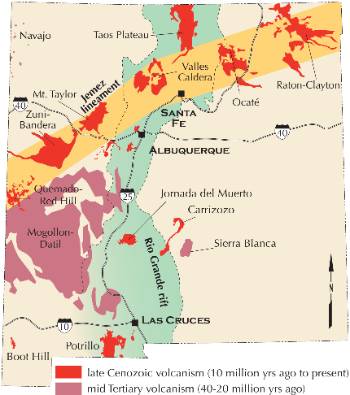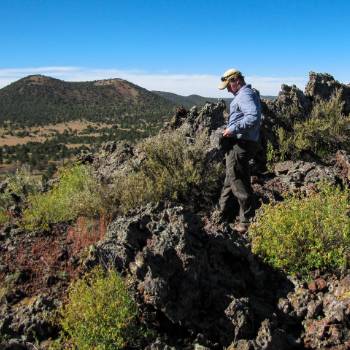New Mexico Bureau of Geology and Mineral Resources to study new carbon sequestration technique
May 3, 2023

Map showing the areas in New Mexico with volcanic rocks of different ages. These volcanic
fields are potential sites for CO2 storage. Map by Matt Zimmerer.
SOCORRO, N.M. -- The New Mexico Bureau of Geology and Mineral Resources (NMBGMR) is one of three collaborators on a project funded by the Department of Energy (DOE) to study a novel carbon sequestration technique. NMBGMR, along with the Department of Earth and Environmental Science and the Petroleum Recovery Research Center at New Mexico Tech (NMT), will explore the feasibility of a relatively new form of CO2 sequestration, one that has the potential to provide permanent storage of carbon.
“The sort of ‘classic style’ of carbon sequestration is to take CO2 and just pump that into the little porous areas in rocks like sandstone,” explains Matt Zimmerer, interim director of the Bureau's mapping division. “The pores are very small —,sub-millimeter type of stuff — but over the scale of an entire basin, there’s potentially a lot of volume there. Ideally, the porous rocks are surrounded by non-porous rocks, and the CO2 will dissolve in groundwater and stay there for a very long time.”
But that method has at least one drawback. “Because you’re pumping in what is essentially a fluid, it can just leak back out in some scenarios,” says Zimmerer.

A new method of carbon sequestration and storage might overcome this challenge. Certain rocks that contain high amounts of calcium or magnesium — like basalt, a type of volcanic rock that is common in New Mexico — have the potential to provide long-term carbon storage. When CO2 is pumped into such rocks, the carbon can react with the calcium (in the case of basalt) and form carbonate minerals, a process known as carbon mineralization.
“Turns out basalt has a lot of calcium in it,” says Zimmerer, “and the idea there is to pump carbon dioxide into a calcium-rich rock and actually precipitate a mineral out. Then it’s locked up as a solid — chemically — and it can’t leak out because it’s in the crystalline structure.” Mixing the CO2 with water before pumping it underground also speeds up the mineralization process.
Zimmerer, a volcanologist by training, has done extensive research on basalts in New Mexico, and this work led to his involvement in the project.
“For the last 10 years or so I’ve been studying these basalts because they’re some of the youngest volcanic rocks in New Mexico, and I’ve been trying to understand them from a volcanic hazards point of view.”
Preliminary results of that study were published in the Winter 2021 issue of New Mexico Earth Matters. Now, that knowledge will be applied to find areas in New Mexico that are best suited to carbon storage using this new technique. “There are some studies that suggest different minerals in basalts or different structures might make them better or worse for this sequestration technique. We need to find places where there’s enough of this material for a large-scale project, and then see if there’s enough of the right kind of material — a Goldilocks situation.”
The NMT collaborators on the $1.2-million DOE grant will take samples of the basalts, look at the chemistry and minerology, and perform small-scale tests using the new sequestration technique. “Preliminary studies show that, after a couple of years, 90% of the CO2 is still locked in the rock structure,” Zimmerer says. “It’s not going to be something that solves all the carbon problems on the planet, but it’s another tool in our bag.”